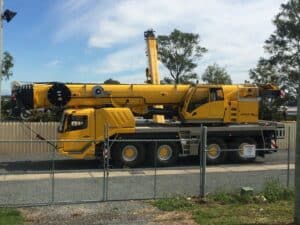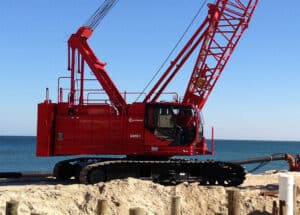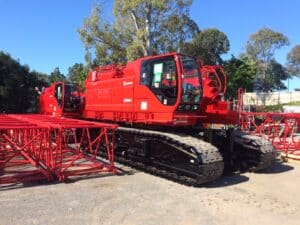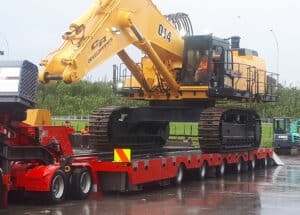The Impact of Cranes on Logistics and Construction

crane near building on cloudly sky background
Importance of logistics and construction in today’s world
Logistics helps to plan and coordinate the supply of goods, materials, services, and information. This includes the organization of all aspects of the supply chain, such as sourcing, warehousing, transportation, and the coordination of activities between different supply chain elements.
Furthermore, a sound logistics system can improve efficiency and productivity, reduce costs, and improve customer satisfaction. The combination of logistics and construction is essential for managing and operating global businesses, as well as for managing the global economy as a whole.
Construction is also crucial to today’s society, as it allows us to build new structures and infrastructure. Construction involves the design, to planning and controlling the construction of structures. This includes the construction of buildings, roads, bridges, walls, and other infrastructure.
Construction also involves the assembling of materials and components, as well as the maintenance of existing structures. It is the process of creating livable and usable spaces that make society function efficiently.
Implications for the Future of Logistics and Construction
Logistics and construction will be revolutionized by technological advancements such as intelligent automation, intelligent tracking, enhanced communication tools, and better inventory management. Intelligent automation will help companies to monitor and control operations in near-real time, allowing them to quickly and easily identify irregularities in order fulfilment, and thus, effectively respond to customer needs.
Additionally, intelligent tracking and enhanced communication tools such as the Internet of Things (IoT) will provide businesses with access to better data on their operations, and improved transparency to enable better decision-making.
Improved data access in the construction industry will promote model-based planning, optimizing project delivery and reducing risks. Utilizing new artificial intelligence (AI) technologies and cloud computing, companies can gain more insights into construction projects in order to better manage costs.
Construction firms can also leverage virtual and augmented reality technologies to more efficiently plan and manage complex projects, providing a safer and more efficient experience for both workers and customers.
Furthermore, new models of collaboration between the logistics and construction sectors will be essential in order for companies to take full advantage of technological developments and reap the benefits of increased efficiency and agility. Vendors, suppliers, third-party logistics companies, construction contractors, and other partners will need to coordinate and integrate their operations in order to optimize the customer experience.
Moreover, they must be willing to work together with customers to develop innovative solutions that can improve project delivery and reduce costs.
Advantages of Using Cranes in Logistics and Construction
One of the most practical advantages of cranes in logistics and construction is their ability to lift extremely heavy loads that would otherwise be very difficult for personnel to move. Even relatively small cranes are powerful enough to lift enormous loads, making them particularly helpful in the industrial sector, where bulky items need to be moved around a lot.
Cranes can also be used to help construct large buildings and are incredibly versatile, allowing construction workers to place materials and equipment in difficult-to-reach places. They can help save time, money, and manpower, and help reduce the amount of physical exertion required for a job.
In addition, cranes can often be rented out for short-term jobs. It’s possible to save a lot of money by hiring cranes on an as-needed basis, rather than purchasing and maintaining your own crane fleet. This is beneficial for those who don’t require a crane all the time, as it can help reduce the financial strain of buying and repairing such a complex piece of equipment.
Another advantage of using cranes in logistics and construction relates to their safety features. Cranes are designed to minimize the risk of accidents, with many models featuring advanced safety features that can limit the amount of potential danger involved in operating a crane. These features can include anti-collision systems, emergency shutoff switches, overload sensors, and other safeguards that ensure the crane operator is able to work safely and efficiently.
Finally, cranes offer excellent flexibility when it comes to working in different locations. With the right crane, you can move goods and materials from one truck to another, or even from one building to the next. This is useful in industries such as manufacturing, where goods need to be transported quickly and safely.
Disadvantages of Using Cranes in Logistics and Construction
One disadvantage of using cranes in logistics and construction is their expense. Cranes have become a costly investment in terms of operational costs. The high maintenance costs associated with cranes can pose a significant financial strain on businesses.
Additionally, the complex operation of most modern cranes means operators must be highly trained and certified. This further increases costs for businesses in need of crane operators.
Another disadvantage of using cranes is the potential risk of accidents. Cranes have a higher-than-usual risk of accidents due to their complex equipment and sheer size. Operating errors and equipment malfunctions can cause serious injury or even death.
This poses a significant risk for both crane operators and those around the area where the crane is being used. Moreover, the operator must be certified and experienced enough to know how to effectively and safely operate a crane.
Lastly, cranes in logistics and construction can be quite noisy. This is especially true for the larger, more powerful cranes built for heavy-duty projects. The noise from cranes can be disruptive to people in the area and has the potential to harm the hearing of those exposed on a regular basis. Moreover, it can be bothersome for those in nearby homes and offices.
Conclusion
Cranes have had a major impact on the logistics and construction industries, enabling greater efficiency while improving building and loading processes. They have enabled the safe and efficient movement of goods and materials, saved time and money on building projects, and even created new job opportunities in the process.
Crane technology continues to advance, providing companies with better options for facilitating the flow of materials and goods from one place to another. With new industries embracing this technology and more job opportunities emerging, it is clear that cranes will remain an invaluable asset to the logistics and construction industries for years to come.





